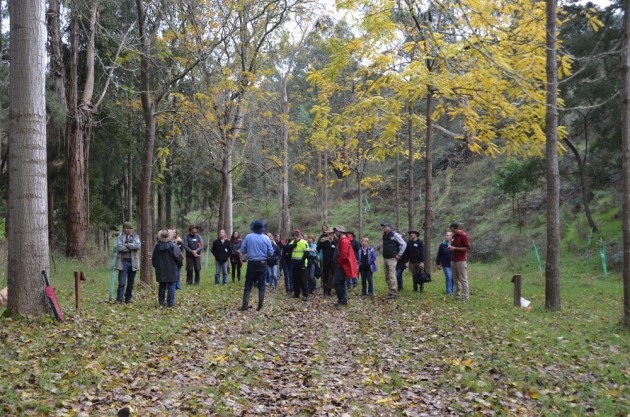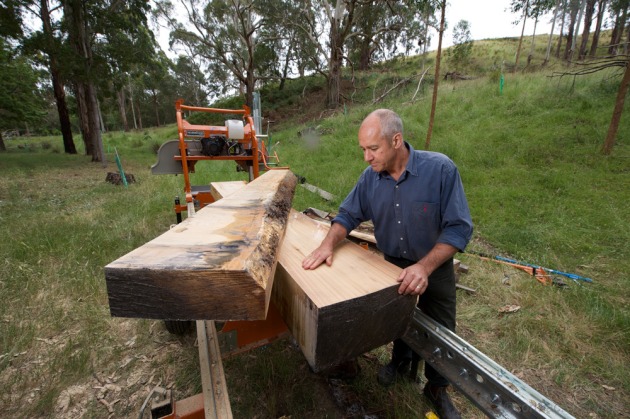Growing trees for profit
Over 10,000 people have visited Rowan Reid’s farm to learn about his experience growing and milling native specialty species.
Words and photos: Rowan Reid
Wood density, tension wood, tangential shrinkage, live knots, natural durability and fiddleback. Experienced woodworkers are familiar with these terms, particularly when working a piece of timber on their saw bench. But what about in the standing tree? How do growth rate, tree management and age affect wood quality in different tree species?
These are questions I have been working on for more than 30 years. In 1987, I was a young forest scientist when I bought a degraded farm in the Otway Ranges in southern Victoria. Having studied the science, my aim was to learn more about growing timber by doing it myself. I also wanted to see if I could make tree growing, particularly the act of cutting them down for timber, attractive to the farming community. If farmers could see value in trees, then they might plant more and that would help control land degradation, improve water quality, enhance biodiversity and lock up carbon for all of us.
Over the years, we have planted thousands of trees of more than 50 different timber species including English oak, coast redwood, blackwood, poplar, sheoaks, black walnut, Australian red cedar, silky oak and, of course, many species of eucalypt. I have also hosted more than 10,000 visitors who have come to our farm to learn about integrating trees into the farming landscape.
I planted trees for conservation, but then I managed them for high quality timber. I pruned the lower branches to eliminate the knots and thinned the trees to promote diameter growth. We continue to graze sheep between the trees to control the fire hazard, or plant an understorey for biodiversity. The result is more like a parkland than a plantation. After 30 years, we are now selectively harvesting sawlogs for on-farm milling and drying using a chainsaw, PTO-driven tractor logging winch, portable bandsaw and solar kiln. And, I am still learning.
There are so many myths about growing timber and many opinions about what affects wood quality in a tree. As a scientist working with farmers, I need to rely on evidence so I make a point of testing theories using my own trees. For example, when a visitor told me that Australian blackwood doesn’t form heartwood until it is at least ten years old, I immediately cut down a 4-year-old tree. It was only 100mm in diameter but it already had band of the dark coloured heartwood running up the stem.
The science tells us that the transition of sapwood to heartwood has very little to do with the age of the tree. The width of the sapwood band simply reflects the water requirements of the canopy. More leaves = higher water requirement = wider sapwood.
There are many other examples: We often hear that young fast-grown eucalypts are no good for timber because the boards bend like bananas when sawn and the wood has a low density. The accepted wisdom amongst many foresters and sawmillers is that it takes at least 60 years to grow a eucalypt suitable for milling.
The author shows the clear timber milled from a 28 year old shining gum (Eucalyptus nitens) grown from his pruned trees. Photo: Cormac Hanrahan
We started producing clear grade, quartersawn eucalypt timber when our trees were just 16 years old. Although the growth rings were more than a centimetre apart, the logs had less tension wood than 65 year old trees of the same species harvested from a native forest. And, the density of the wood produced in the years leading up to our harvest was no different to that from the mature trees. The logs in that trial were only 50cm in diameter. We are now milling 30 year old trees that are over 75cm in diameter from which I can cut 6–8" wide quartersawn boards that are clear of knots.
Again, the practice confirms the science: Once eucalypts reach about 20 metres in height, well spaced and pruned trees of any age will produce mature timber on their lower stem. Juvenile wood only forms close to the active canopy; pruning for timber increases the density of the stem wood.
When we started milling our eucalypts we did notice there was a lot of fiddleback showing up on the quartersawn face. This alone was proof that fiddleback is not caused by slow or twisted growth. We reviewed the science. Although I can’t be sure, my current view is that pruning live branches off the stem can initiate a reaction in the cambium that spreads down the trunk resulting in a wavy grain that persists for many years.

A table made by the author from 25 year old mountain ash (Eucalyptus regnans) stands amongst 29 year old high-pruned trees of the same species. Photo: Cormac Hanrahan
Science is about testing ideas, building knowledge and being willing to change your view when the evidence proves otherwise. The art of tree growing, like the art of woodworking, is more personal. It’s about the application of the science and practice in ways that create something unique, such as a beautiful and productive landscape. Also, like woodworking, a master tree grower will never boast that they know it all. There is always more to learn.
In Heartwood: the art and science of growing trees for conservation and profit* I share my own experience and that of hundreds of researchers, farmers and tree growers that I have met over the years. I hope the book inspires farmers to plant and manage trees for high quality timber and encourages woodworkers to use Australian farm-grown timber in their next building project or furniture piece. It is only by doing and sharing that we will learn.
* Rowan Reid’s book features 15 of the specialty timber species that the author has grown and technical sections on tree growth, management and processing.
Rowan Reid is a forest scientist and over the last 30 years has grown more than 50 special timber species on his farm. Learn more at www.agroforestry.net.au




